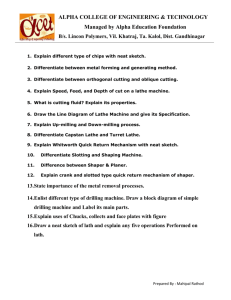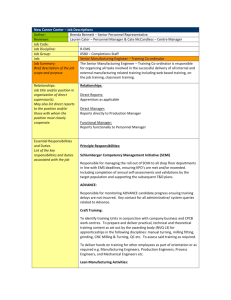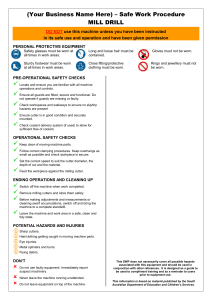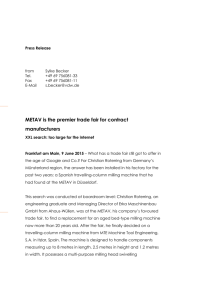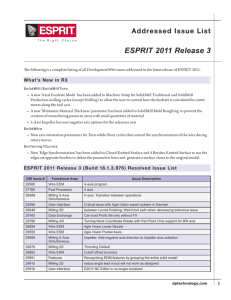Milling Machine Overview
advertisement
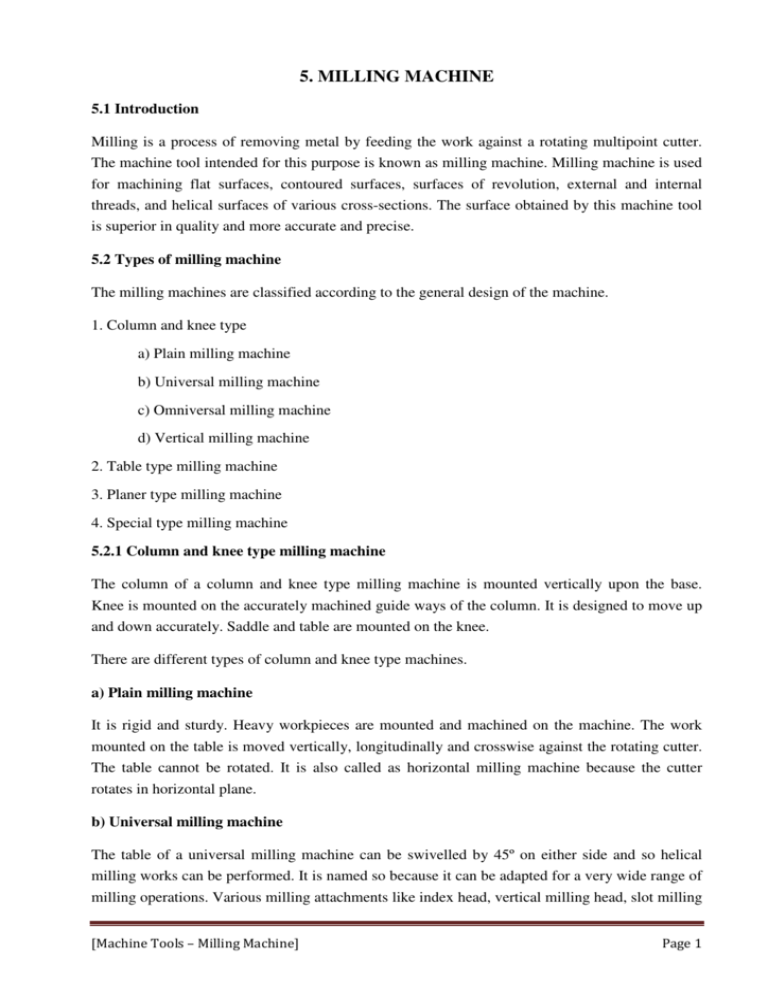
5. MILLING MACHINE 5.1 Introduction Milling is a process of removing metal by feeding the work against a rotating multipoint cutter. The machine tool intended for this purpose is known as milling machine. Milling machine is used for machining flat surfaces, contoured surfaces, surfaces of revolution, external and internal threads, and helical surfaces of various cross-sections. The surface obtained by this machine tool is superior in quality and more accurate and precise. 5.2 Types of milling machine The milling machines are classified according to the general design of the machine. 1. Column and knee type a) Plain milling machine b) Universal milling machine c) Omniversal milling machine d) Vertical milling machine 2. Table type milling machine 3. Planer type milling machine 4. Special type milling machine 5.2.1 Column and knee type milling machine The column of a column and knee type milling machine is mounted vertically upon the base. Knee is mounted on the accurately machined guide ways of the column. It is designed to move up and down accurately. Saddle and table are mounted on the knee. There are different types of column and knee type machines. a) Plain milling machine It is rigid and sturdy. Heavy workpieces are mounted and machined on the machine. The work mounted on the table is moved vertically, longitudinally and crosswise against the rotating cutter. The table cannot be rotated. It is also called as horizontal milling machine because the cutter rotates in horizontal plane. b) Universal milling machine The table of a universal milling machine can be swivelled by 45º on either side and so helical milling works can be performed. It is named so because it can be adapted for a very wide range of milling operations. Various milling attachments like index head, vertical milling head, slot milling [Machine Tools – Milling Machine] Page 1 head and rotary table can be mounted. It can machine drills, reamers, gears, milling cutters with a very high degree of accuracy and so it finds an important place in a workshop. c) Omniversal milling machine In addition to the table movements obtained in a universal milling machine, the knee can be tilted to a required angle. It is useful for machining helical grooves, reamer and bevel gears. It is mostly used in tool room work. d) Vertical milling machine A spindle of a vertical milling machine is positioned at right angles to the table. The cutter is moved vertically or at an angle by swivelling the vertical head of the machine. The machine is adapted for machining slots and flat surfaces by moving the table. By mounting end mills and face milling cutters on the spindle, vertical milling and internal milling are preformed 5.3 Main Parts of Column and knee type milling machine Base It is made of cast iron and supports all the other parts of the machine tool. A vertical column is mounted upon the base. In some machines, the base serves as a reservoir for cutting fluid. [Machine Tools – Milling Machine] Page 2 Column It is mounted upon the base and is box shaped. It houses the mechanism for providing drive for the spindle. The front vertical face of the column is machined accurately to form dovetail guide ways for the knee to move up and down. The top of the column holds an overhanging arm. Knee It slides up and down on the guide ways of the column. An elevating screw mounted on the base obtains this movement. Saddle is mounted upon the knee and moves in a cross direction. Saddle It is mounted on the guide ways of the knee and moves towards or away from the face of the column. This movement can be obtained either by power or by hand. The top of the saddle has guide ways for the table movement. Table The table is moved longitudinally either by power or manually on the guide ways of the saddle. The trip dogs placed on it control the movement of the table. The table of a universal milling machine can be swivelled horizontally to perform helical works. The top surface of the table has got ‘T’ – slots on which the workpieces or other work holding devices are mounted. Spindle It is located in the upper part of the column. It receives power from the motor through belt, gears and clutches. The front end of the spindle has got a taper hole into which the cutters are held with different cutter holding devices. Overhanging arm It supports the arbour from the top of the column. The arbour is supported by the bearing fitted within the arbour support. It is also useful while using some special attachments. Front brace It is an extra support fitted between the knee and the overhanging arm. It is slotted to allow the knee to be adjusted vertically. Arbor It supports the different types of cutters used in the machine. It is drawn into the taper hole of the spindle by a draw bolt. One or more cutters are mounted on the arbour by placing spacing collars between them. The arbour is supported by an arbour support. The arbour is provided with a Morse taper or self-releasing taper. [Machine Tools – Milling Machine] Page 3 5.3.1 Vertical milling machine It is very similar to a horizontal milling machine in construction as it has the same parts of base, column, knee, saddle and table. The spindle of the machine is positioned vertically. The cutters are mounted on the spindle. The spindle is rotated by the power obtained from the mechanism placed inside the column. Angular surfaces are machined by swivelling the spindle head. [Machine Tools – Milling Machine] Page 4 5.4 Size of a milling machine The size of a milling machine is specified as follows 1. The size of the table (length and width) 2. The maximum lengths of longitudinal, cross and vertical travel of the table. 3. Number of spindle speeds, number of feeds 4. Spindle nose taper 5. Power required 6. Net weight of the machine 7. The floor space required 8. Type of the machine 5.5 Milling Operation - Peripheral milling The machining is performed by the cutting edges on the periphery of the milling cutter. It is classified under two headings 1. Up milling 2. Down milling Up milling In this method, the workpiece mounted on the table is fed against the direction of rotation of the milling cutter. The cutting force is minimum during the beginning of the cut and maximum at the end of cut. The thickness of chip is more at the end of the cut. As the cutting force is directed upwards, it tends to lift the workpiece from the fixtures. A difficulty is felt in pouring coolant on the cutting edge. Due to these reasons the quality of the surface obtained by this method is wavy. This processes being safer is commonly used and sometimes called conventional milling. Down milling The workpiece mounted on the table is moved in the same direction as that of the rotation of the milling cutter. The cutting force is maximum at the beginning and minimum at the end of cut. The chip thickness is more at the beginning of the cut. The workpiece is not disturbed because of the bite of the cutter on the work. The coolant directly reaches to the cutting point. So the quality of surface finish obtained is high. Because of the backlash error between the feed screw of the table and the nut, vibration is setup on the workpiece. [Machine Tools – Milling Machine] Page 5 5.6 Work holding devices For effective machining operations, the workpieces need to be properly and securely held on the machine table. The following are the usual methods of holding work on the table : 1. Vises : i. Plain vise ii. Swivel Vise iii. Universal Vise 2. V- Block 3. Clamps, T bolts 4. Angle Plate [Machine Tools – Milling Machine] Page 6 5.7 Cutter holding devices Depending on the design of the cutter, there are several methods of supporting milling cutters on the machine spindle. 1) Arbor 2) Collet 3) Adapter 4) Screwed on cutters 5.7.1 Arbor Milling cutters with central holes are mounted and keyed on a shaft called arbour. There are three different types of arbour namely Pilot end arbour, ‘A’ type arbour and stub arbour. 5.7.2 Collet It is a form of sleeve bushing used to hold arbors or cutters having a smaller shank than the spindle taper. Collets are connected to the spindle by a drawbolt and the rotary motion is transmitted to the cutters. Fig. 5.10 shows a collet. 5.7.3 Adapters Milling cutters having shanks are generally mounted on adapters. The outside taper of the adapter conforms to the taper hole of the spindle. The shank of the cutter fits into the taper hole of the adapter. An adapter is shown in Fig. 5.11 5.7.4 Screwed arbour The small cutters having threaded holes at the center are held by screwed arbors. It has a threaded nose at one end and a taper shank at the other end. The shank of the arbour is mounted on the spindle. . [Machine Tools – Milling Machine] Page 7 5.8 Standard milling cutters There are different types of milling cutters used in a milling machine. A suitable milling cutter is selected according to the need. They are 1. Plain milling cutter 2. Side milling cutter 3. Metal slitting saw 4. Angle milling cutter 5. End milling cutter 6. ‘T’ – Slot milling cutter 7. Fly cutter 8. Formed cutter [Machine Tools – Milling Machine] Page 8 5.9 Milling machine operations The following operations are performed using suitable milling cutters. 1. Plain milling 9. Flute milling 2. Face milling 10. Keyway milling 3. Side milling 11. Drilling & reaming 4. Straddle milling 12. Boring 5. Angular milling 13. Gear cutting 6. Gang milling 14. Thread milling 7. Form milling 15. Cam milling 8. End milling [Machine Tools – Milling Machine] Page 9 5.10 Milling machine attachments The milling machine attachments are intended for the purpose of developing the range of operations, versatility, production capacity and accuracy of machining process. The different milling machine attachments are: 1) Vertical milling attachment 2) Universal milling attachment 3) High speed milling attachment 4) Slotting attachment 5) Rotary table attachment 6) Indexing head attachment 5.11 Indexing head Indexing is the method of dividing the periphery of a piece of work into any number of equal parts. The attachment used for performing indexing is known as indexing head. The indexing operation can be adapted for cutting gears, ratchet wheels, keyways, fluted drills, taps and reamers. The indexing head serves as an attachment for holding and indexing the work in doing the above tasks. There are three different types of indexing heads namely: 1. Plain or simple dividing head 2. Universal dividing head 3. Optical dividing head. [Machine Tools – Milling Machine] Page 10 The construction of a universal dividing head as shown in Fig. 5.29 Working principle of dividing head When the crank is rotated with help of a handle through the required number of holes in the index plate, the work is rotated to required amount. This is possible because of the worm and worm wheel mechanism. A gear train is arranged between the main spindle and the driven shaft when indexing is done by differential indexing method. The work is rotated as usual when the handle is rotated. At the same time, the index plate is also made to rotate a small amount through the gear train. When indexing is by this differential indexing method, the index plate is released from the lock pin. 5.12 Indexing methods There are several methods of indexing and they are 1. Direct or rapid indexing 2. Plain or simple indexing 3. Compound indexing 4. Differential indexing 5. Angular indexing [Machine Tools – Milling Machine] Page 11


